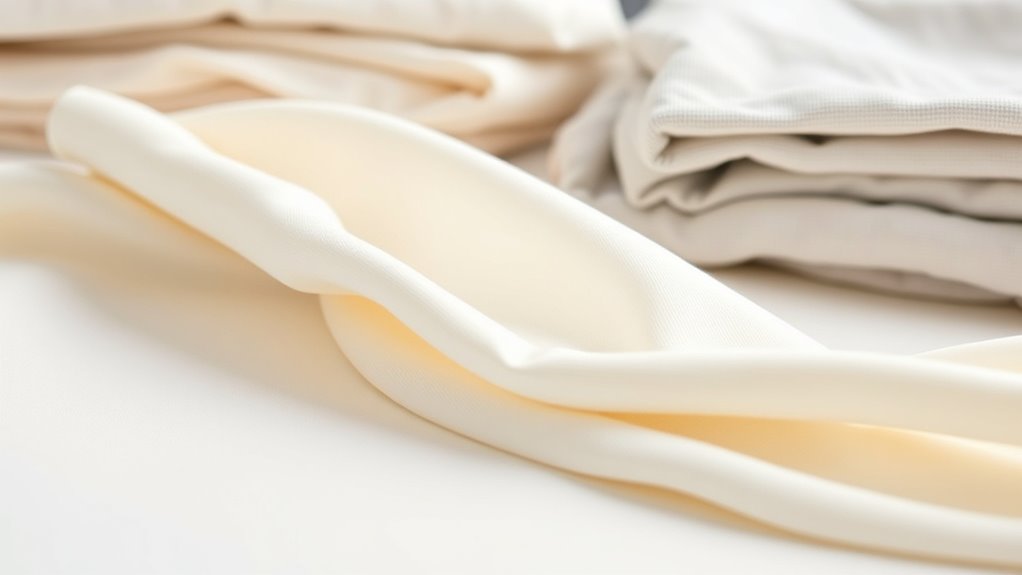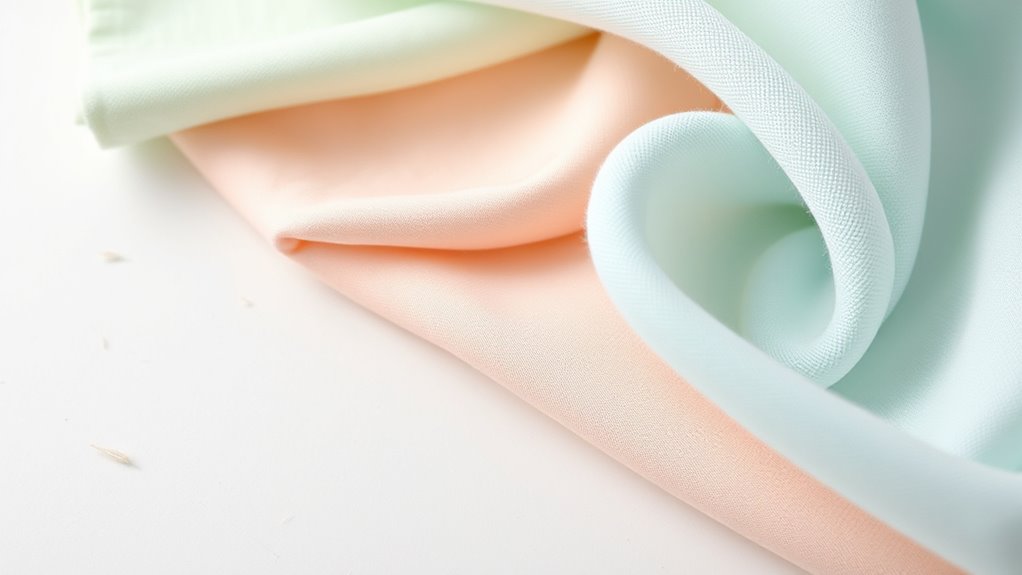To avoid allergic reactions, steer clear of fabrics like wool, which contains lanolin, and synthetic materials like polyester and acrylic that trap heat and irritants. Be cautious with dyes, especially conventional ones that may contain formaldehyde, azo dyes, or heavy metals; opt for natural or dye-free options instead. Also, avoid chemically treated fabrics, such as those with formaldehyde resins or wrinkle-resistant finishes. If you want to learn more about making your wardrobe allergen-free, keep exploring.
Key Takeaways
- Avoid fabrics containing irritating dyes, heavy metals, or formaldehyde to minimize allergic reactions.
- Steer clear of wool and coarse fibers that can trigger skin sensitivities.
- Refrain from synthetic fabrics like polyester and acrylic, which may contain chemicals and cause irritation.
- Skip chemically treated or finished fabrics, such as wrinkle-resistant or stain-proof textiles.
- Be cautious with vintage or second-hand clothing, as they may contain irritants like mothballs or harsh detergents.

For people with allergies, finding clothing that doesn’t trigger reactions can be a challenge. Many fabrics, dyes, and treatments used in standard clothing can cause skin irritation or allergic responses. To minimize these risks, it’s essential to choose materials that are less likely to provoke a reaction. Hypoallergenic fabrics are designed specifically for sensitive skin, so look for options like organic cotton, bamboo, or silk, which typically contain fewer irritants. These fabrics are often processed without harsh chemicals, making them gentler on your skin and reducing the chance of allergic reactions.
Choose hypoallergenic fabrics like organic cotton, bamboo, or silk for sensitive skin.
Another major concern is irritating dyes. Traditional dyes used to color clothing can contain chemicals and synthetic dyes that irritate sensitive skin or trigger allergies. Many conventional dyes include irritants like formaldehyde, azo dyes, or heavy metals, which can cause redness, itching, or more severe reactions. When shopping for allergy-friendly clothing, always check for products labeled as free from irritating dyes or those that use natural or plant-based dyes. These options tend to be free of synthetic chemicals and are less likely to cause skin issues.
Avoiding certain fabrics altogether can also help prevent allergic reactions. Wool, for example, contains lanolin, which some people are allergic to, and its coarse fibers can irritate delicate skin. Similarly, synthetic fabrics like polyester or acrylic often contain chemicals from manufacturing processes and can trap heat and moisture, creating an environment conducive to irritation or fungal infections. If you’re prone to allergies, it’s best to steer clear of these materials or opt for high-quality, tightly woven versions that reduce contact with irritating substances.
Chemically treated or heavily processed fabrics are another culprit. Many clothing manufacturers use treatments such as formaldehyde resins or chemical finishes to make clothes wrinkle-free or stain-resistant. These treatments can linger on the fabric and cause skin irritation over time, especially for sensitive skin types. When selecting allergy-friendly clothes, look for labels indicating the fabric is free from chemical treatments or that it has been processed with hypoallergenic methods.
Additionally, the role of colorfastness in reducing allergic reactions is important, as poorly dyed garments may bleed or transfer irritants onto the skin. Lastly, be cautious with vintage or second-hand clothing, as they may have been exposed to irritants like harsh detergents, mothballs, or other chemicals. Always wash new clothes before wearing them, and consider choosing organic or natural fibers with minimal or no chemical processing. By being mindful of fabrics and dyes, you’ll considerably reduce the risk of allergic reactions and enjoy more comfortable, irritation-free clothing options tailored to sensitive skin.
Frequently Asked Questions
Are Synthetic Fabrics More Allergenic Than Natural Fibers?
You might wonder if synthetic fabrics are more allergenic than natural fibers. Synthetic fiber sensitivities can develop because these materials often trap irritants and don’t breathe well. Natural fiber benefits include better breathability and fewer irritants, making them gentler for sensitive skin. So, if you’re concerned about allergies, you may find natural fibers like cotton or wool preferable, as they tend to cause fewer reactions compared to synthetic fabrics.
Can Laundry Detergents Affect Clothing’s Allergy Friendliness?
You might find it surprising, but laundry detergent ingredients can impact your allergy friendliness. Harsh chemicals or fragrances in detergents can leave residues that irritate sensitive skin or trigger allergies. To keep your clothes truly allergy-friendly, follow allergy-friendly washing tips like choosing fragrance-free, hypoallergenic detergents and rinsing thoroughly. This way, you reduce potential allergens and keep your skin safe, making laundry an easy part of your allergy management.
Do Fabric Dyes Contribute to Allergic Reactions?
Fabric dye allergies can definitely cause allergic reactions, especially if you’re sensitive to certain dye ingredient sensitivities. When you wear clothing with artificial dyes, you might experience skin irritation or rashes. To minimize this risk, look for dye-free or naturally dyed fabrics. Always check labels for dyes that could trigger your allergies, and consider washing new clothes before wearing them to reduce residual dye exposure.
How Can I Test if a Fabric Causes Allergies?
Imagine you’re a pioneer exploring uncharted territory—testing fabrics for allergies. To do fabric allergy testing, start by wearing a small piece of the fabric on your skin for 48 hours, watching for redness or itching. For safer choices, look into hypoallergenic fabric options made from natural fibers like organic cotton or bamboo. If reactions occur, consult a dermatologist for professional testing and guidance on suitable fabrics.
Are There Specific Brands Known for Allergy-Friendly Clothing?
You can find brands known for allergy-friendly clothing by looking for hypoallergenic certifications and eco-friendly labels. These brands prioritize using gentle, non-irritating materials and avoid harsh chemicals. Research online for trusted companies like Patagonia or Eczema Honey that focus on hypoallergenic and eco-conscious products. Always check labels for certifications to guarantee the clothing meets your allergy needs, making your wardrobe safer and more comfortable.
Conclusion
By choosing allergy-friendly fabrics, you create a gentle haven against irritation, wrapping yourself in soft, breathable layers that feel like a soothing breeze on your skin. Imagine slipping into clothing that whispers comfort, free from harsh chemicals and itchy fibers. With each mindful choice, you protect your skin’s delicate landscape, allowing you to move through your day with ease and confidence. Embrace these materials, and let your wardrobe become a cozy sanctuary you truly enjoy.










